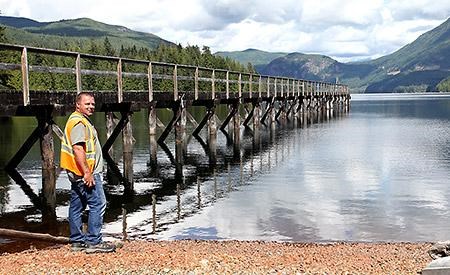Consumers of water in Powell River have heeded conservation warnings and have made significant reductions in consumption.
At the Tuesday, August 4 committee of the whole meeting, Tor Birtig, the City of Powell River’s director of infrastructure, said he was following up on a report from Frank D’Angio, the city’s manager of engineering services, who had reported to the committee of the whole on Thursday, July 14, outlining water levels and conservation.
Birtig said the city’s Haslam Lake water level is eight weeks lower than where it normally is this time of year. With public awareness from news articles and media reports bringing greater focus on water conservation, there has been a noticeable response.
“We’ve seen drops in our water consumption for the last three weeks,” Birtig said. “In the past reported week we were down 30 per cent from what we had at the end of June.
“Keep in mind that Haslam Lake does not typically rise until the beginning of October so we probably have about eight or nine more weeks of potential dropping,” he said, adding that for every millimetre of rain which falls on the lake’s watershed, the lake level rises about seven millimetres.
To encourage water conservation compliance, the city has increased the hours of bylaw staff to monitor and enforce sprinkling regulations in the city. Birtig said he did not have any evidence because the increase in hours started late last week.
The city has also made contact with the Lang Creek Hatchery and Spawning Channel and received comment that its operators are satisfied with the condition of the wetted area of Lang Creek. The water temperature is sufficiently low that the introduction of Haslam Lake water into the creek is not distressing the fish. The average temperature in the creek is about 18C so it is cool enough and within tolerance for the fish stocks.
Birtig said Haslam Lake itself is still in pretty good condition in terms of water level. Most of the drop in the lake is not as a result of human consumption, but rather, through diversion through the fish weir and evaporation.
“Our consumption only accounts for 20 to 25 per cent of that drop,” Birtig said. “Even if we were to reduce our consumption to nothing our lake level would continue to drop with this kind of weather.”
The city will continue to monitor the situation and look at the effectiveness of bylaws.
“We will be watching out for compliance on the sprinkling regulations,” Birtig said. “We will see if we require further restrictions. At this time it’s education for the public to not waste our valuable resource.”’
Mayor Dave Formosa asked how much water there was above the Haslam Lake intake. Birtig said there was slightly less than five feet of water.
“What you’ll see if this continues to drop is not so much of a problem for our distribution, but it would be for the discharge into the slough area of Haslam,” he said. “You would see restricted flows going into the Lang Creek system.
Formosa said he understands there is a minimum amount the city must put through into the Lang Creek system.
Birtig said the flow was close to the minimum. The regulations were set in the late 1950s as to what the city must contribute to Lang Creek.
“What we’ve found is we are more effective in dealing with the hatchery with respect to fishery flows,” he said. “They are well aware of what we are facing today and the potential for lower flows in the creek.”
In times of high temperatures, smaller contributions to the creek from the lake can be beneficial so that the temperatures in the fish-rearing environment are not elevated. Regardless, at this time, the city is meeting its regulatory requirements.
Formosa asked what would happen if the city had no rain until the end of September. Birtig said the city is in the same water situation as it has been for three times in the last 25 years.
“We made it through those periods without any real issue,” he said. “We are still in a good state.”



